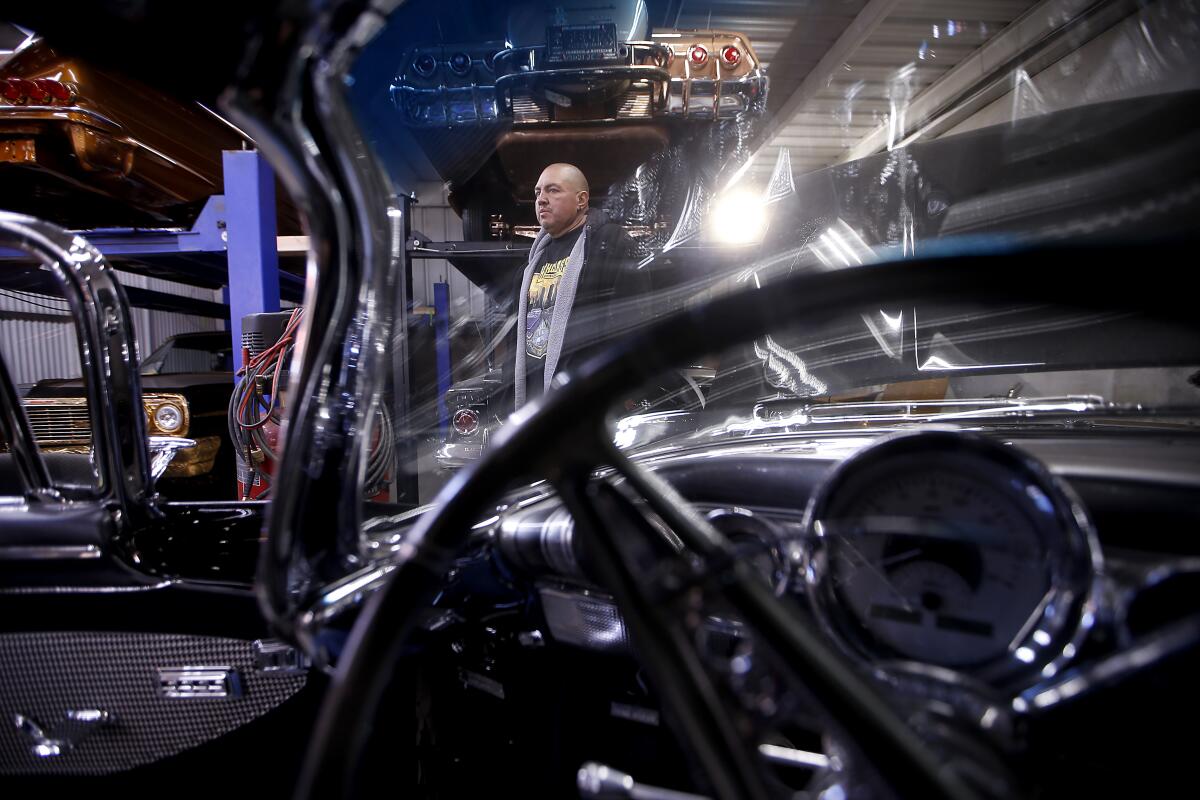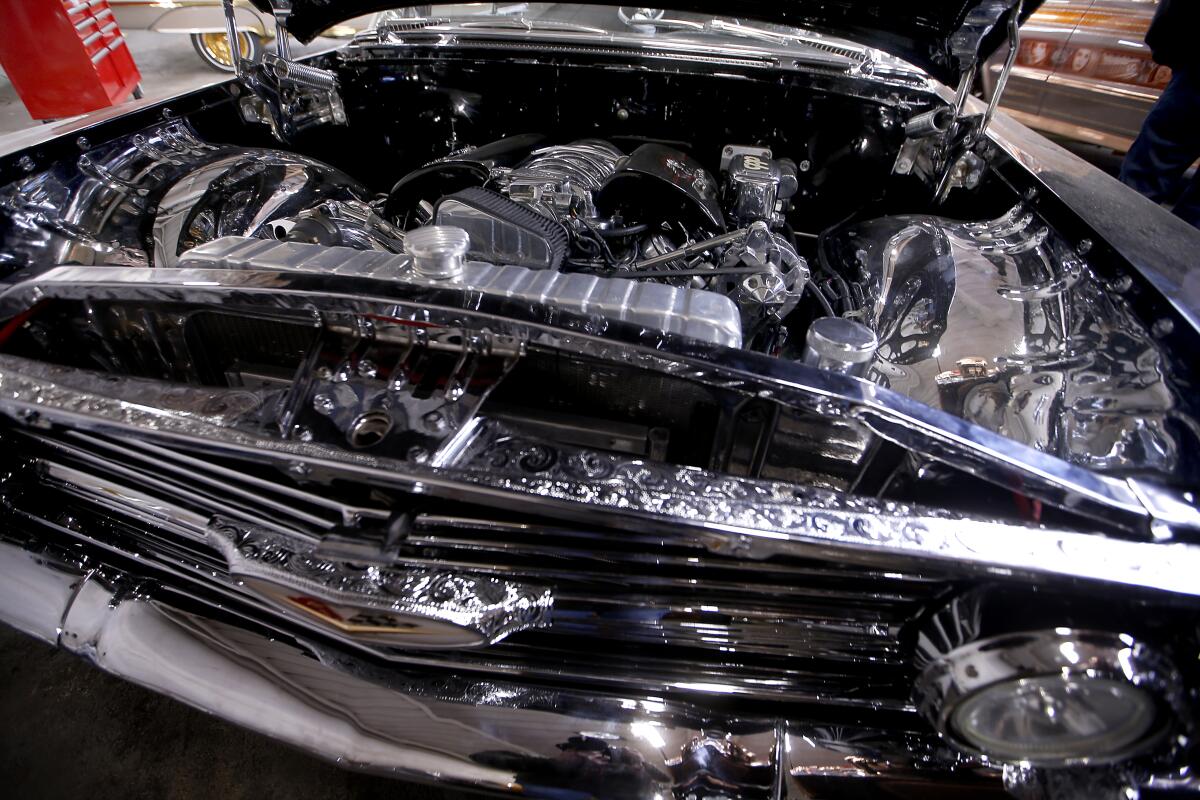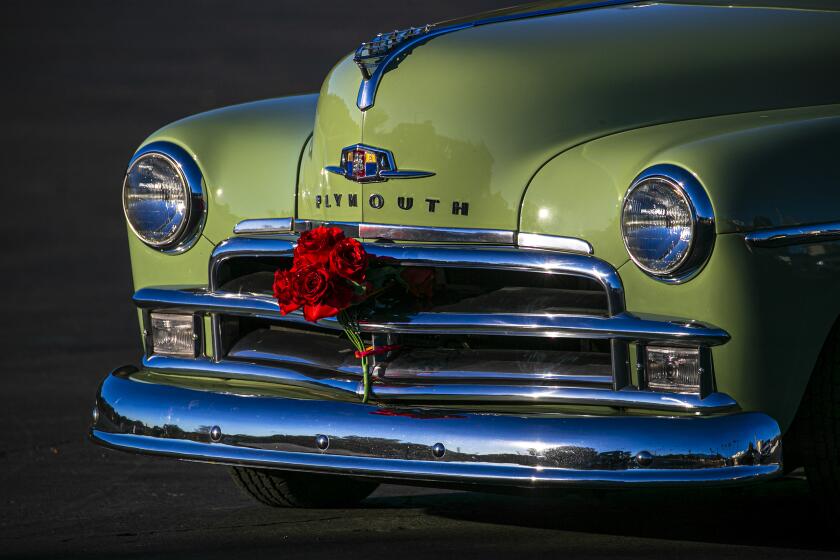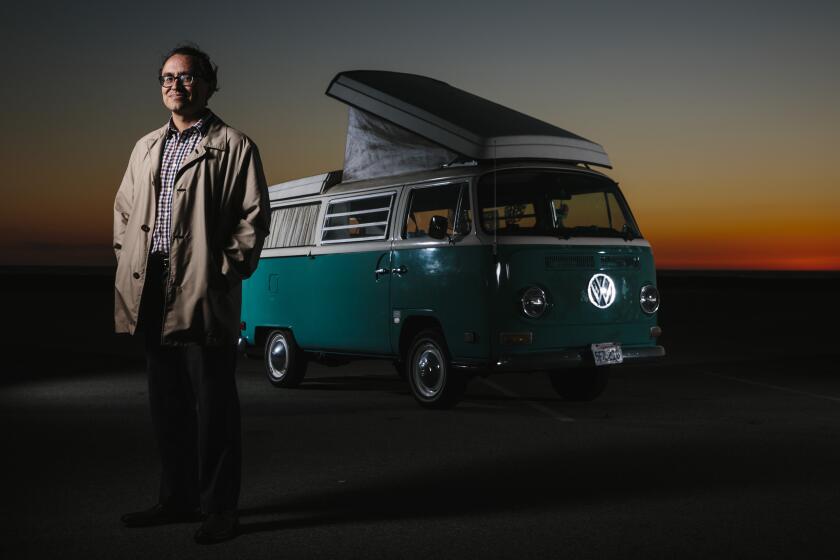Column: Why California’s anti-chromers can’t see the forest for the trees

As far back as he can remember, Luis “Speedy” Rodriguez has been all about chrome.
Growing up in his native Mexico City, he confessed, “I wouldn’t get on buses if they weren’t arreglados” — tricked out.
After migrating to the United States as a teenager, Rodriguez so wanted to work at a chroming facility that he started by cleaning bathrooms and delivering parts. For free.
All these decades later, Rodriguez, now 50, is a chroming legend. His filigreed handiwork decorates hundreds of lowriders across Southern California. His cars have appeared in Audi commercials, Travis Scott music videos and promotions for Hollywood films.
Rodriguez’s “retirement” is a collection of Chevrolet Impalas from 1958 to 1964 — the best years of the iconic model — stored in a garage at his business, Speedy’s Metal Finishing in Long Beach. They’re plated with enough shiny material — chrome, yes, but also copper, rose gold, stainless steel, even 24-karat gold — to make diamonds seem as bright as a cardboard tube.
All around us were hundreds of chromed parts — bolts, suspension coils, A-Arms, gas tanks, tire rims — on the ground, on shelves, on tables and even offices.
“Chrome is magic,” Rodriguez said as we walked around his compound. “When you see it on a car, it’s inexplicable.”
I agree. When I look at the grille of my 1974 Cadillac Eldorado convertible, it’s like a portal to another world, one where everything is gleaming, hardworking people take care of what they own, and life is just cruising.
I visited Rodriguez with the hopes of seeing a rusty bumper transform into a shimmering beaut. But he now outsources that work to finishers in Santa Fe Springs and Fullerton. When I asked why, he laughed.
“Oh no,” Gonzalez replied. “They have to deal with everything. City. Fire department. OSHA, AQMD. Even if I had the money, I wouldn’t do it. Let them deal with the headaches.”

Last month, the California Air Resources Board held a public hearing to discuss the use of hexavalent chromium, a compound that gives chromed products — not just automobile parts but faucets and appliances — their alluring shine. The finished product is harmless, but the plating process, which involves dunking parts in a chemical bath, produces airborne emissions 500 times more toxic than diesel exhaust.
The air resources board has heavily regulated hexavalent chromium in California since it was identified as an toxic air contaminant in 1986. Now, the board is considering a total ban on its use by 2039. So-called decorative chrome platers like Rodriguez would have to stop by 2027, because many operate near working-class neighborhoods. Platers will have to switch to less toxic — and less shiny, and more expensive — chroming material, something Rodriguez doesn’t think his peers and customers will embrace.
We stood in front of a black 1960 Impala to admire the trim that spanned the length of the car’s side. One half was chromed, the other stainless steel.
Which was which?
I guessed correctly — the stainless steel was slightly duller. Only a gearhead could tell the difference. Gonzalez explained that the steel is far cheaper than chroming, but few customers ask for it.
“It’s always about el bling,” he explained with a sympathetic shrug.
The board will make its final decision in May. Gonzalez was matter of fact when I asked about the possible ban. “There’s been talk about it for years, so I’ll believe it when I see it,” he said. But the usually jovial man then turned quiet.
“This is the majority of my life. ... It would be sad. There’s people who’ve been doing this for a lot of years, and — boom! — no job.” He noted that customers would just ship out parts to other states, or drive down to Tijuana.
“What makes it funny,” Gonzalez concluded, “is [California] wanted to make marijuana legal, and now chrome is illegal. Drugs are poison, but it’s now more respectable in California to sell drugs.”
California regulators want to ban a toxic chrome-plating chemical that gives a signature metallic shine to auto parts and other products.
Banning carcinogenic pollutants is a noble cause. But the more I read through the California Air Resources Board’s 253-page report, the more I felt its authors were committing two bureaucratic sins more and more in vogue in Sacramento: Create a solution in search of a problem, and miss the forest for the trees.
Hexavalent chromium contamination is no joke. It was the pollutant in the lawsuits that made Erin Brockovich famous. In the late 1990s, a cancer cluster sprouted in Suva Elementary and Intermediate Schools in Bell Gardens that led to a legal settlement against a nearby chromer. In 2017 and 2018, a Paramount company temporarily suspended some operations thrice after it exceeded hexavalent chromium levels set by the South Coast Air Quality Management District, a case study that the board’s report cited.
I expected to find more examples like these that might justify the accelerated push against decorative chromers like Gonzalez. But when I asked the board for stats on elevated rates of cancer among Californians who live near such businesses, information officer Melanie J. Turner responded, “We are not aware of any data.” Turner also forwarded a statement from the California Office of Environmental Health Hazard Assessment that admitted the same.
Both agencies emphasize the potential risks of any exposure near platers that use hexavalent chromium. But if the mere hint of danger is what’s driving the ban, then the California Air Resources Board is ignoring its own findings. Decorative and industrial chromers accounted for just 0.4% of all hexavalent chromium emissions in 2020 that board staffers were able to trace. Far worse polluters are lumber manufacturers, glass producers and even the gas stoves that so many Californians use.
Learning how to work on your car is a rite of passage in car culture, a torch passed from hot rodders to lowriders, van-life hipsters to import-car enthusiasts.
The biggest culprit by far? Vehicle exhaust and burning fossil fuels.
So why focus on decorative chromers, I asked Gonzalez? Or why not just relocate them far away from residents, or just require even more regulations?
“Es pura política,” he replied, using a line — it’s pure politics — the rancho libertarians in my life always use to explain away political silliness. “There’s some better things we need to take care of.”
State lawmakers have zeroed in on California’s car culture for years in the name of environmental justice and fighting climate change. The air resources board already voted last year to stop the sale of all new gas-powered cars by 2035. Legislators passed two laws aimed at targeting noisy cars. Los Angeles is considering banning new gas stations.
All these moves are well-intentioned. But they target a way of life whose last admirers and defenders are mostly working-class people of color — an easy sacrifice on the altar of saying you’re saving the planet. The board admits as much: It forecasts that banning hexavalent chromium in favor of more expensive alternatives will “result in a further competitive disadvantage and potential closures of chrome plating businesses” and “negative employment impacts.”
But oh well!

Rodriguez’s workers began to stroll in as I prepared to leave. They greeted Erasmo Gonzalez, a winemaker who’s been a customer for a decade. He drove in that morning from Delano to check on parts for his 1975 Chevrolet Caprice convertible.
“I think they’re full of it,” said the 42-year-old, who wore a Los Angeles Dodgers cap with his last name stitched on the side. “Wildfires put all sorts of bad stuff in the air. Why don’t they ban those?”
Erasmo noted that air quality in Southern California has dramatically improved over the decades through cleaner fuels and better engines even as the population has increased and more vehicles are on the road than ever.
“Technology improves things,” he said. “There’s always a way to fix it. Don’t just ban to ban.”
More to Read
Sign up for Essential California
The most important California stories and recommendations in your inbox every morning.
You may occasionally receive promotional content from the Los Angeles Times.













